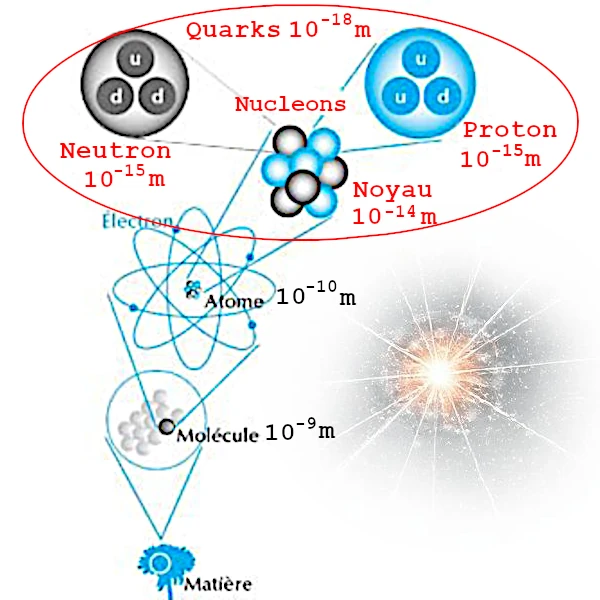
Hadrons are composite subatomic particles, formed by quarks held together by the strong interaction, the most powerful fundamental force in nature. They are divided into two main families: baryons (such as protons and neutrons), composed of three quarks, and mesons, composed of a quark-antiquark pair.
The theory describing the strong interaction is Quantum Chromodynamics (QCD). According to this theory, quarks carry a "color charge" and exchange gluons, the carriers of the strong interaction. A crucial property of QCD is confinement: quarks cannot exist in isolation and are always confined within hadrons.
The binding energy of a hadron can be described by the relation \(E = \sqrt{(pc)^2 + (mc^2)^2}\), where \(m\) is the rest mass of the hadron, \(p\) its momentum, and \(c\) the speed of light.
N.B.:
Quantum Chromodynamics (QCD) is the theory that describes the strong interaction between quarks and gluons. It is based on the SU(3) gauge symmetry and explains quark confinement, i.e., the impossibility of observing them in isolation, as well as asymptotic freedom, where the force decreases at very short distances.
A few microseconds after the Big Bang, the Universe was so hot and dense that quarks and gluons existed as a quark-gluon plasma. At that time, the temperature exceeded \(10^{12}\,\text{K}\), preventing quarks from binding into stable particles. When cosmic expansion caused the temperature to drop below this critical value, quarks began to confine through the strong interaction, giving rise to the first hadrons (protons and neutrons).
This process of hadronization occurred about \(10^{-6}\,\text{s}\) after the initial moment. The protons and neutrons formed during this time became the primordial baryonic matter, a precursor to primordial nucleosynthesis (between 1 and 3 minutes after the Big Bang), which allowed the formation of the first helium, deuterium, and lithium nuclei.
The LHC at CERN is the most powerful instrument ever built to study hadrons. By colliding protons at energies reaching 6.8 TeV per beam, it recreates the extreme conditions that prevailed in the primordial universe, just after the Big Bang (\(t < 10^{-6}\) s).
These collisions produce a multitude of exotic hadrons, allowing physicists to test the predictions of the Standard Model and search for physics beyond this model. The discovery of the Higgs boson in 2012 is a notable example.
Neutron stars, ultra-dense remnants of supernovae, are natural laboratories for studying hadronic matter under extreme conditions. Their cores reach densities that can exceed \(3 \times 10^{17}\) kg/m³, several times nuclear density.
In these environments, the pressure is so intense that hadrons could "melt" into a quark-gluon plasma, a state of matter that would have existed in the primordial universe. The equation of state of high-density hadronic matter \(P(\rho)\) remains one of the great challenges of contemporary physics, with implications for understanding the maximum possible mass of neutron stars.
The world of hadrons is extremely varied and rich, making it one of the most fascinating and complex families of particles. The study of hadrons connects the most fundamental particle physics to the astrophysics of the densest objects in the universe.
Thus, the world of hadrons is much more than a simple collection of particles. It is a complex and dynamic ecosystem that is at the heart of our understanding of what constitutes the visible matter of our universe, from atomic nuclei to neutron stars.
| Hadron | Symbol | Composition | Mass (MeV/c²) | Charge | Spin | Classification |
|---|---|---|---|---|---|---|
| Proton | p | uud | 938.3 | +1 | 1/2 | Baryon |
| Neutron | n | udd | 939.6 | 0 | 1/2 | Baryon |
| Positive pion | π⁺ | u\(\bar{d}\) | 139.6 | +1 | 0 | Meson |
| Neutral pion | π⁰ | u\(\bar{u}\)/d\(\bar{d}\) | 135.0 | 0 | 0 | Meson |
| Positive kaon | K⁺ | u\(\bar{s}\) | 493.7 | +1 | 0 | Meson |
| Neutral kaon | K⁰ | d\(\bar{s}\) | 497.6 | 0 | 0 | Meson |
| Eta | η | Mixture of quark-antiquark pairs | 547.9 | 0 | 0 | Meson |
| Rho | ρ⁺ | u\(\bar{d}\) | 775.3 | +1 | 1 | Meson |
| Delta | Δ⁺⁺ | uuu | 1232 | +2 | 3/2 | Baryon |
| Lambda | Λ⁰ | uds | 1115.7 | 0 | 1/2 | Baryon |
| Positive sigma | Σ⁺ | uus | 1189.4 | +1 | 1/2 | Baryon |
| Neutral sigma | Σ⁰ | uds | 1192.6 | 0 | 1/2 | Baryon |
| Xi | Ξ⁰ | uss | 1314.9 | 0 | 1/2 | Baryon |
| Omega | Ω⁻ | sss | 1672.5 | -1 | 3/2 | Baryon |
| J/Psi | J/ψ | c\(\bar{c}\) | 3096.9 | 0 | 1 | Meson |
| Upsilon | ϒ | b\(\bar{b}\) | 9460.3 | 0 | 1 | Meson |
Source: Particle Data Group and CERN.